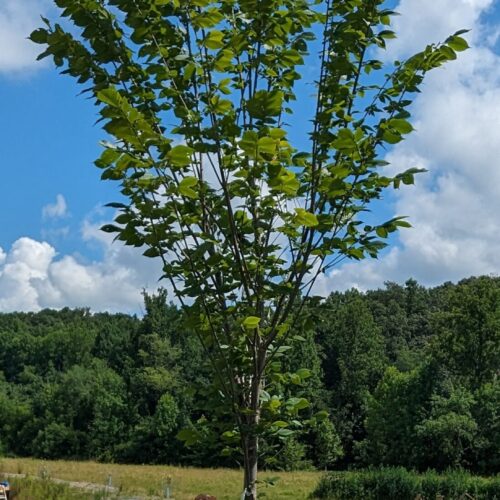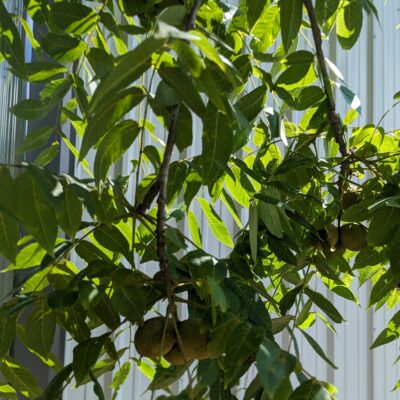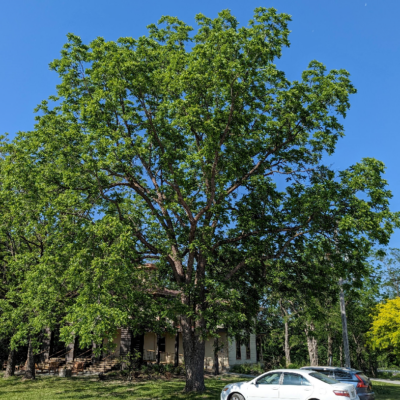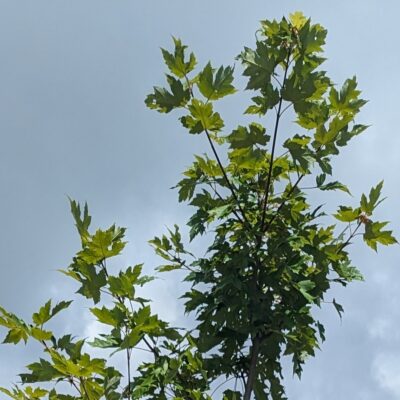In this second part of the series of the Shade Trees of Summer, we’ll consider five additional trees worthy of consideration including black walnut, red maple and sugar maples, chestnut and American elm. These are all native and/or hybrids of native trees.
Black Walnut (Juglans nigra)
The black walnut is a member of the family Juglandaceae. It is a native tree highly valued for its timber. Its nuts are edible and are important to sustaining wildlife (especially squirrels), which in turn propagates the tree by conveniently forgetting where it has left its stash. It is late to leaf out in spring, and with its compound foliage, the tree imparts a tropical feel. The roots produce juglone which is toxic to some plant species, notably tomato plants and apple trees. It has most recently been the focus of studies for thousand cankers disease and as a host for spotted lanternfly.
Best planted as a woodland edge tree, or naturalized in larger properties. The nuts may drive some people nuts when it comes to fall cleanup.
- Native tree
- Late to leaf out in spring – one of the last trees to leaf out in spring
- Leaves are pinnately compound, almost tropical looking
- Produces edible nuts
- Produces juglone, which is toxic to some plants including tomatoes and apples
- Susceptible to 1000 cankers disease, a fungal disease
- A host for spotted lanternfly, an exotic planthopper
Black walnut foliage, nuts, and mature tree
Maples
Red Maple (Acer rubrum) is a native tree in the family Sapindaceae (formerly, Aceraceae). Red maple blooms very early in spring, an important early pollinator species. It has grayish bark that flakes in a fish scale pattern when older. Its branching has an opposite pattern of growth. Its leaves are palmate and lobed. Its fruits are two-winged samaras or ‘whirlygigs’. The tree grows best in moist soil in full sun. The brilliant red fall color is best in acidic soils. There are a number of cultivars in the trade often selected for fall color, such as ‘October Glory’.
Silver maple (Acer saccharinum) is also a native tree preferring moist soils. It is a fast-growing tree with a decurrent habit of growth. This means that it forms many competing leaders that often are poorly attached, leading to branch failure in future years. Silver maple has cut-lace foliage with a silvery underside.
The Freeman maple, a hybrid of red and silver maples, that combines the brilliant fall color and strong branch attachments of the former with the fast growth of the latter. It is also less susceptible to interveinal chlorosis of either species when grown in high pH (alkaline) soils.
- Native tree
- Leaves are simple, often with three lobes and have an opposite branching pattern
- Brilliant fall color
- pH dependent – in acidic soils, red; in alkaline soils, yellow
- prefers moist soils
- Susceptible to SLF
- Cultivars and hybrids in the trade (Acer x freemanii)
- Acer x freemanii is a cross of red and silver maples
Red maple, silver maple, and Freeman maple
Sugar Maple (Acer saccharum)
The sugar maple is a native tree that has exceptional fall colors of yellow, orange to burnt-orange on the same tree. As implied by its name, this tree is tapped for its sugary sap for maple syrup in early spring: 40 to 44 gallons of sap needs to be collected and reduced for one gallon of syrup!
Plant in full sun in well drained soil. Add one inch of compost and mulch well. Keep watered the first year or two after planting. Delay pruning until the tree is in full leaf, as pruning prior to bud break results in bleeding from the cut points.
- Native tree
- Leaves are simple, often with three lobes and have an opposite branching pattern
- Brilliant fall color
- Grows in full sun and partial shade
- Will grow in a wide range of soil pH’s
- Tapped for maple syrup
- Prefers well drained, loamy soils
- Does not tolerate droughty conditions
- Susceptible to Asian longhorned beetle, an exotic wood borer
- Prune trees in winter prior to sap rising – trees bleeding

American Chestnut (Castanea dentata)
The chestnut was an important component of the overstory forest in the east. It produced both timber and nuts that supported wildlife. However, an exotic fungus (native to Southeast Asia) introduced early in the 1900s devastated the forest stands of the east.
Chestnut Blight
The fungus Cryphonectria parasitica (formerly Endothia parasitica) is the causal agent of a bark canker that girdles and kills the tree. The American chestnut now only exists as a remnant in eastern forests, in habit, a multi-stemmed shrub. Efforts, however are being made to restore the American chestnut tree.
Plant hybrid trees that are resistant to chestnut blight. Hybrids of the native and Chinese chestnut such as ‘Revival’ or hybrids of the European and Japanese chestnut, such as ‘Colossal’. Plant in full sun spacing trees 36’ apart. Plant at least two trees for greater harvests.
- Native tree
- Was an important mast tree in eastern forests
- Devastated by an introduced canker disease (Cryphonectria parasitica)
- American Chestnut Foundation is working on restoring the American chestnut
- Hybrids of dentata x C. mollissima are disease resistant as are hybrids of C. sativa x C. crenata

American elm (Ulmus americana)
Elm is native tree in the family Ulmaceae. The tree has a decurrent form sending up numerous leaders (stems) whose branching become pendant at the ends. The tree forms a vaselike to umbrella-shaped habit, like no other shade tree. Widely planted for the nation’s centennial on main streets throughout the US, its mature canopy created cool, shaded allées under which to stroll. Unfortunately, at the turn of the last century, a fungal disease that incited a vascular wilt was introduced that virtually devastated the American elm.
Dutch elm Disease (DED)
Ophiostoma-novo-ulmi (formerly Ceratocystis ulmi) is an exotic fungus that infects the vascular tissues of the tree. It occludes the sapwood vessels, restricting the flow of water into the canopy causing wilt symptoms. The initial branch wilting is termed “flagging.” The fungus can enter the tree in one of two ways: by an insect vector, or by root grafts. Two species of bark beetles can introduce fungal spores. The native elm bark beetle (Hylurgopinus rufipes) and the smaller European elm bark beetle (Scolytus multistriatus). Early season feeding of these bark beetles in the branch crotch of trees introduces spores that rapidly grow and cause wilt from the top down. Infected trees growing nearby a healthy elm can spread the growing fungus via root grafts.
Protecting Mature Elms
Susceptible elms may be protected with a systemic fungicide. The most effective approach is to treat elms when they are healthy. Fungicides in the triazole class protect the tree by preventing spores from germinating and causing infection. An example of a protective fungicide is propiconazole; Propizol (Arborjet, Inc.) is labeled for DED. Applications ought to be conducted by a professional applicator. Always read and follow the label instructions when using registered pesticides.
Planting Elms
Plant resistant elm cultivars. There are a number of trees available in the trade that offer good to excellent resistance to DED. The Princeton, Valley Forge, Accolade, and New Harmony have vase shaped crowns; Jefferson, Frontier and Homestead have upright crowns.
Plant trees in full sun, and mulch well; prefers moist, well-drained soil. Prune trees only in the winter months when bark beetles are inactive.
- Native tree
- Unique umbrella shaped habit
- Planted for the nations’ centennial across the country
- Introduced vascular wilt fungus (Ophiostoma novo-ulmi) causal of DED
- Susceptible to elm yellows
- Planr cultivars resistant to DED
- Prune trees in dormant season when the vector (European elm bark beetle) is inactive

Join me next week when we talk again about microbes – but this time, the ones you want.
~ Signing off for now, Joe







